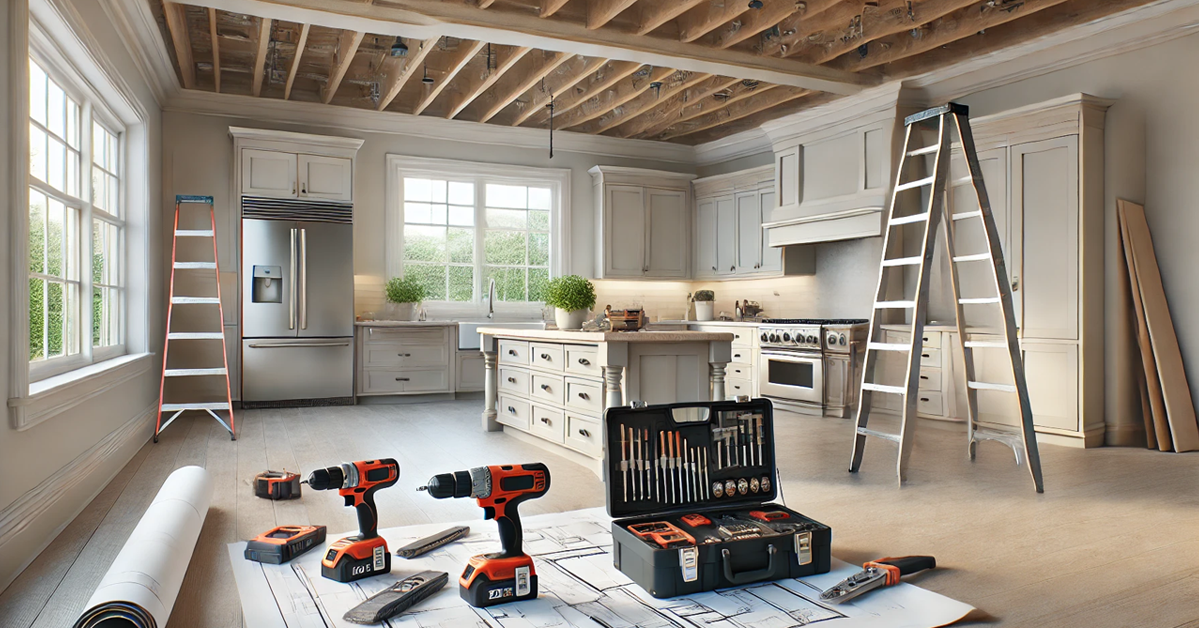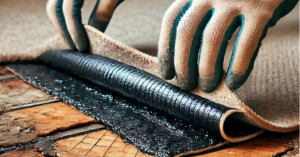TL;DR
If you’re remodeling a home built before or after 1970, asbestos may be present due to the use of stockpiled asbestos-containing materials. Only lab testing by certified professionals can confirm asbestos. Homeowners are legally permitted to remove asbestos, but they must follow strict regulations, conduct thorough research on compliance, and avoid uncertified contractors. Improper removal can lead to contamination and costly decontamination. Hiring licensed professionals is the safest, most efficient option for managing asbestos properly during renovations.
Introduction
If you’ve recently purchased a home built before 1970, or even during or after the 1970s, you may be eager to start remodeling. However, asbestos was commonly used in many building materials during this time. Although asbestos became regulated in the late 1970s, older stockpiles of asbestos-containing materials (ACMs) were still used in construction well into the 1980s and possibly beyond. This guide will help homeowners understand the risks of asbestos, how it relates to renovations, and the legal requirements for safely handling it. It’s important to remember: only proper testing by an accredited lab can confirm if a material contains asbestos.
Step 1: Identifying Where Asbestos Might Be in Your Home
If your home was built before 1970, it’s highly likely that asbestos-containing materials may be present. However, homes built in the 1970s and even later may still have asbestos because contractors often used stockpiled materials. Since there’s no definitive endpoint for when these materials stopped being used, it’s crucial to understand where asbestos might be in your home.
Common places where asbestos might be found include:
- Insulation: Asbestos was frequently used in insulation materials for walls, attics, and around pipes due to its heat-resistant properties.
- Flooring: Vinyl tiles and the adhesives used to install them may contain asbestos. This is especially common in homes with multiple layers of flooring, as older layers may still be in place beneath newer ones.
- Roofing Materials: Asbestos was commonly used in roofing shingles, underlayment, and felt. These materials can still be found in homes that were built or had roofing replaced with older stock.
- Drywall and Joint Compound: The compound used to seal drywall joints often contained asbestos, especially in older homes.
- Ceiling Textures: “Popcorn ceilings” were frequently made using asbestos, and they remain in many homes today, even those built in the late 20th century.
Important Note: You cannot confirm the presence of asbestos by visual inspection alone. Only proper testing by a certified professional and an accredited lab can verify if asbestos is present.
Helpful Hint: Avoid disturbing materials that may contain asbestos until testing has been conducted. Disturbing asbestos-containing materials can release harmful fibers into the air, potentially causing health hazards.
Step 2: Hire a Certified Inspector for Asbestos Testing
Once you’ve identified areas in your home that may contain asbestos, it’s crucial to hire a certified inspector to conduct a survey. The inspector will collect samples from suspected materials and send them to an accredited lab for proper testing. Only lab testing can confirm the presence of asbestos. Here’s why it’s important to leave the testing process to certified professionals:
- Cross-Contamination Risks: If you attempt to collect samples yourself, improper handling can lead to cross-contamination. This may result in false positives or inaccurate results, potentially inflating the cost of removal work by flagging areas as contaminated that may not actually contain asbestos.
- Safety and Legal Concerns: Disturbing asbestos without proper safety measures could expose you and your family to asbestos fibers. Certified inspectors follow strict safety protocols to ensure that asbestos fibers aren’t released during the sampling process.
- Contractor Requirements: Many contractors, including general contractors, electricians, and demolition crews, may refuse to work with owner-conducted testing. They often require a certified inspector to conduct the asbestos survey to ensure the samples were collected safely and properly. This ensures that the results are reliable and that their crews aren’t exposed to asbestos during the renovation process.
Certified inspectors have the training and equipment necessary to safely collect samples, ensuring that the process is compliant with regulations. The results from the accredited lab can then be used to guide the next steps in your renovation safely.
Helpful Hint: Keep all testing documentation and lab results. They will be essential for future renovations or when selling your home.
Step 3: Legal Requirements for Homeowners Doing Asbestos Removal
While homeowners are legally permitted to remove asbestos themselves, strict regulations must be followed. These regulations are designed to protect health and safety, as improper handling of asbestos can lead to contamination and exposure risks. Homeowners must research and fully understand all local, state, and federal regulations that apply to asbestos removal before proceeding. It’s critical to comply with these regulations to avoid severe consequences.
If you choose to remove asbestos yourself, the law requires that you:
- Use Personal Protective Equipment (PPE): You must wear full-body disposable coveralls, gloves, and a respirator equipped with HEPA filters to prevent exposure to asbestos fibers.
- Establish Worksite Containment: The area where asbestos removal is taking place must be fully sealed with heavy-duty plastic sheeting to contain the fibers. You’ll also need to create a decontamination area to safely remove your protective gear without tracking asbestos into other parts of the home.
- Use Negative Air Machines: These machines create a vacuum effect and filter out asbestos fibers using HEPA filters. Negative air pressure ensures that fibers don’t escape from the worksite into the rest of your home.
- Utilize HEPA-Equipped Tools: Any vacuums or tools used in the removal process must have HEPA filters to trap asbestos fibers. Regular tools and vacuums without HEPA filtration can spread asbestos fibers rather than contain them.
- Follow Proper Disposal Procedures: After removal, all equipment and materials used must be properly decontaminated, and asbestos waste must be disposed of according to local regulations at specialized facilities.
- Familiarize Yourself with Additional Regulations: More regulations apply to asbestos abatement, and you must fully understand the legal requirements in your area before starting any project on your property.
Failure to comply with these requirements can result in severe contamination of your home, exposing your family to asbestos and leading to costly decontamination efforts.
Additionally, general contractors who are not certified for asbestos abatement cannot legally remove asbestos. While some contractors may claim they can handle asbestos-containing materials or untested questionable materials, they lack the necessary training, equipment, and experience. Hiring uncertified contractors puts your home at risk for improper removal, which can lead to contamination and legal liabilities. Furthermore, you won’t have the documentation showing that removal was done properly by an accredited abatement company, which can cause problems if you decide to sell your home in the future.
Helpful Hint: Full decontamination of a home is extremely expensive and will likely outweigh the cost of doing the removal properly in the first place.
Step 4: Removal vs. Encapsulation – Which Option Is Best?
When asbestos is discovered in your home, you’ll have two primary options for dealing with it: removal or encapsulation. The best approach depends on the condition of the material, the extent of your renovation, and whether the material will be disturbed during the work.
- Removal: This involves completely removing asbestos-containing materials from your home. It is often the best option when the material is in poor condition or if your renovation work will disturb it. Removal ensures that asbestos will no longer pose a risk to future occupants or renovation projects. However, it can be more expensive than encapsulation due to the extensive precautions required.
- Encapsulation: Encapsulation involves sealing the asbestos-containing material with a protective coating, which prevents fibers from becoming airborne. This option is more cost-effective and is typically chosen when the asbestos-containing material is in good condition and will not be disturbed. Additionally, encapsulation can also involve physically sealing the material, such as installing new flooring over asbestos-containing vinyl. The key is that the process does not disturb the asbestos material.
Both options require careful consideration and must be performed by trained professionals to ensure that the asbestos is handled safely and in compliance with local regulations. Discuss your specific situation with a licensed asbestos contractor to determine which solution is best for your home.
Helpful Hint: During renovations, it’s possible to uncover new asbestos-containing materials that were not visible or accessible during initial testing. For example, an asbestos-wrapped air duct hidden inside a wall may be exposed during demolition. These newly discovered materials will require testing and, if necessary, additional abatement.
Step 5: Planning for Future Renovations
Once asbestos has been properly addressed—whether through removal or encapsulation—it’s essential to keep records and take precautions for future renovations. Here’s what to keep in mind:
- Maintain Documentation: Keep all records of asbestos surveys, lab testing, and abatement work. These documents are essential for future renovations and may be required if you sell your home. They serve as proof that asbestos was handled properly.
- Care with Encapsulated Materials: If asbestos has been encapsulated, it’s important to avoid disturbing the encapsulated material during future renovations. If the encapsulated material must be disturbed, additional safety precautions and testing will be required to ensure asbestos fibers are not released.
Proper documentation and attention to encapsulated asbestos will help ensure that your home remains safe for future renovations and occupants.
Disclaimer:
This article is for informational purposes only and is not a substitute for legal or professional advice. Always consult with a certified asbestos abatement professional or legal advisor to understand the full scope





